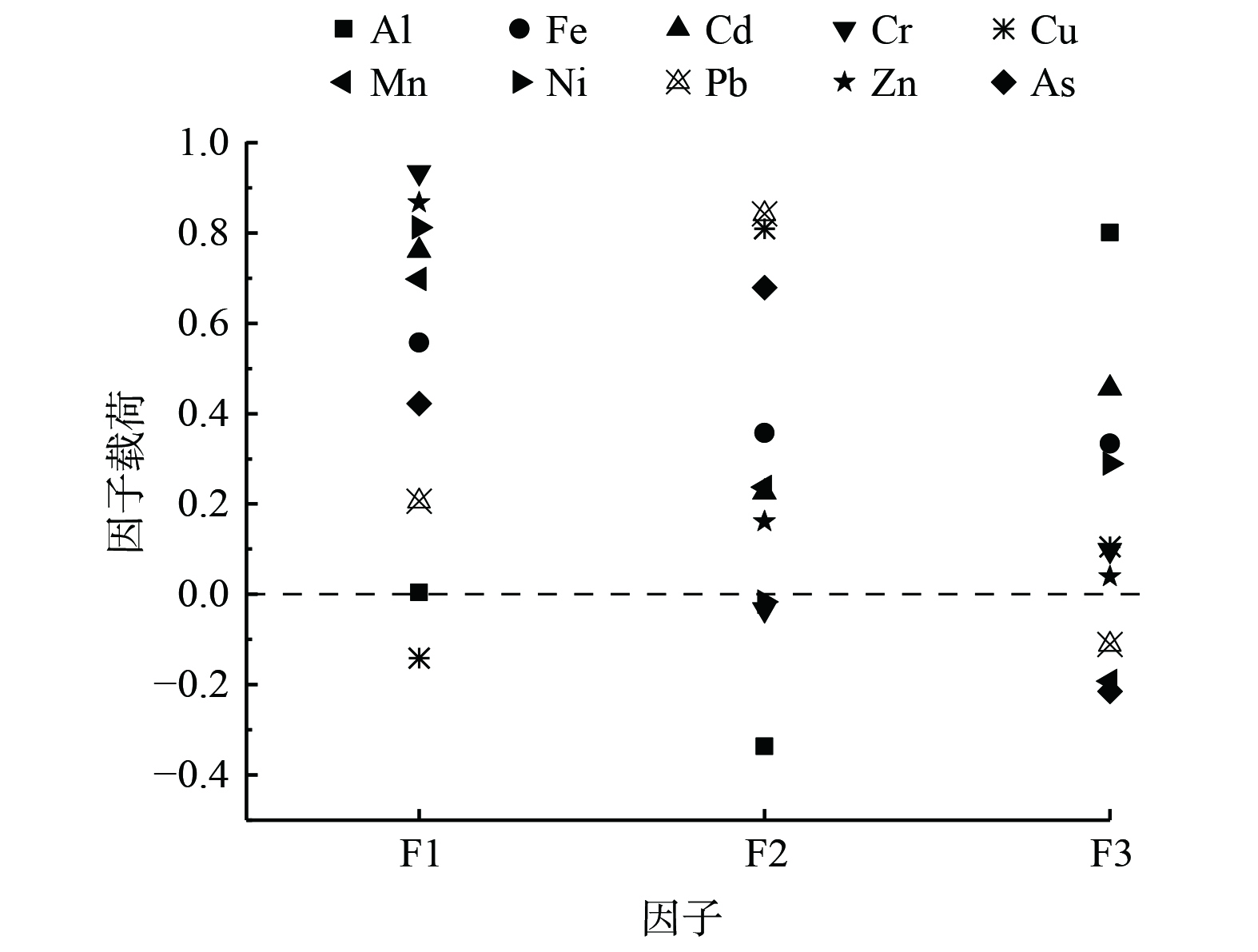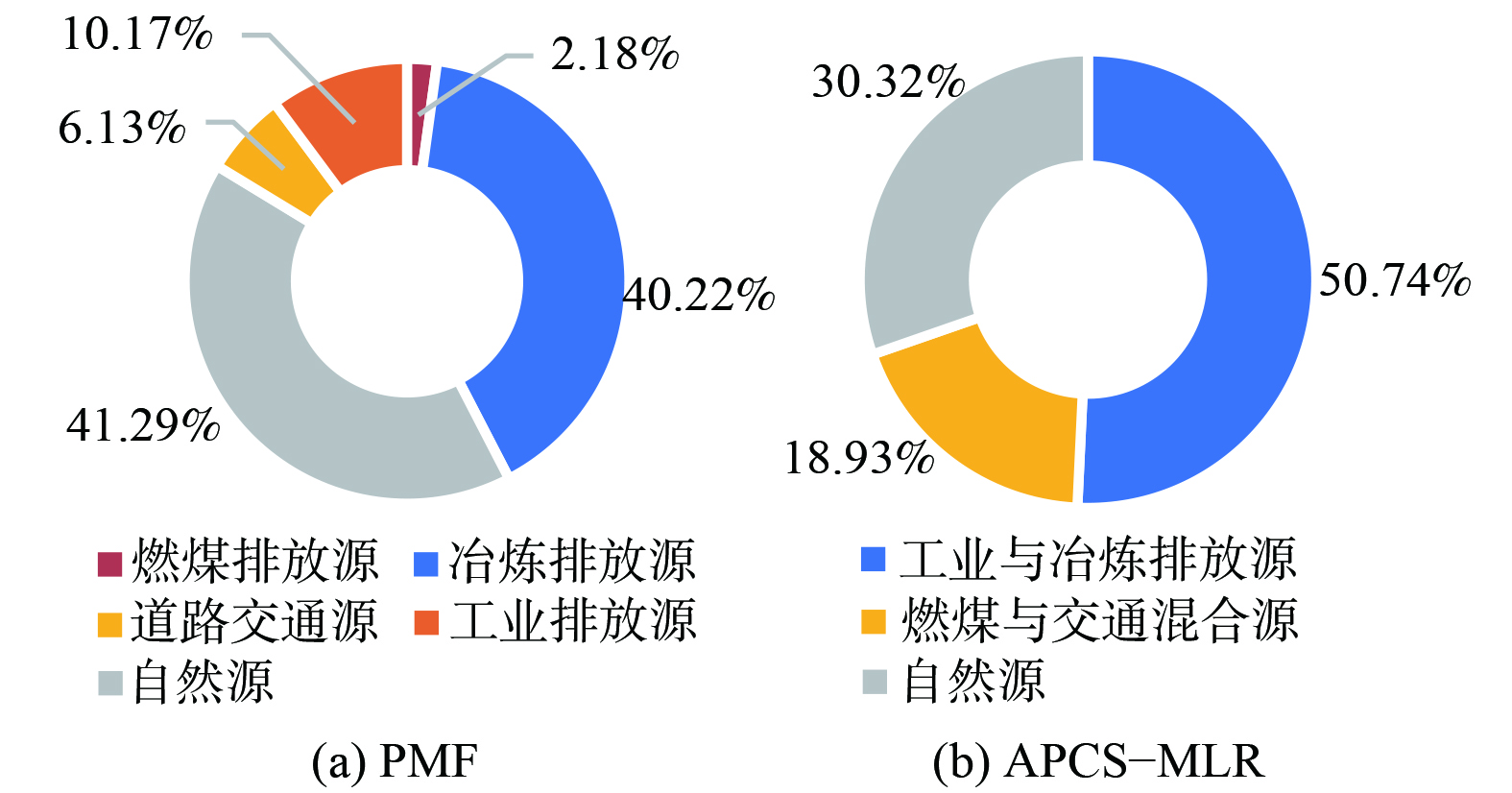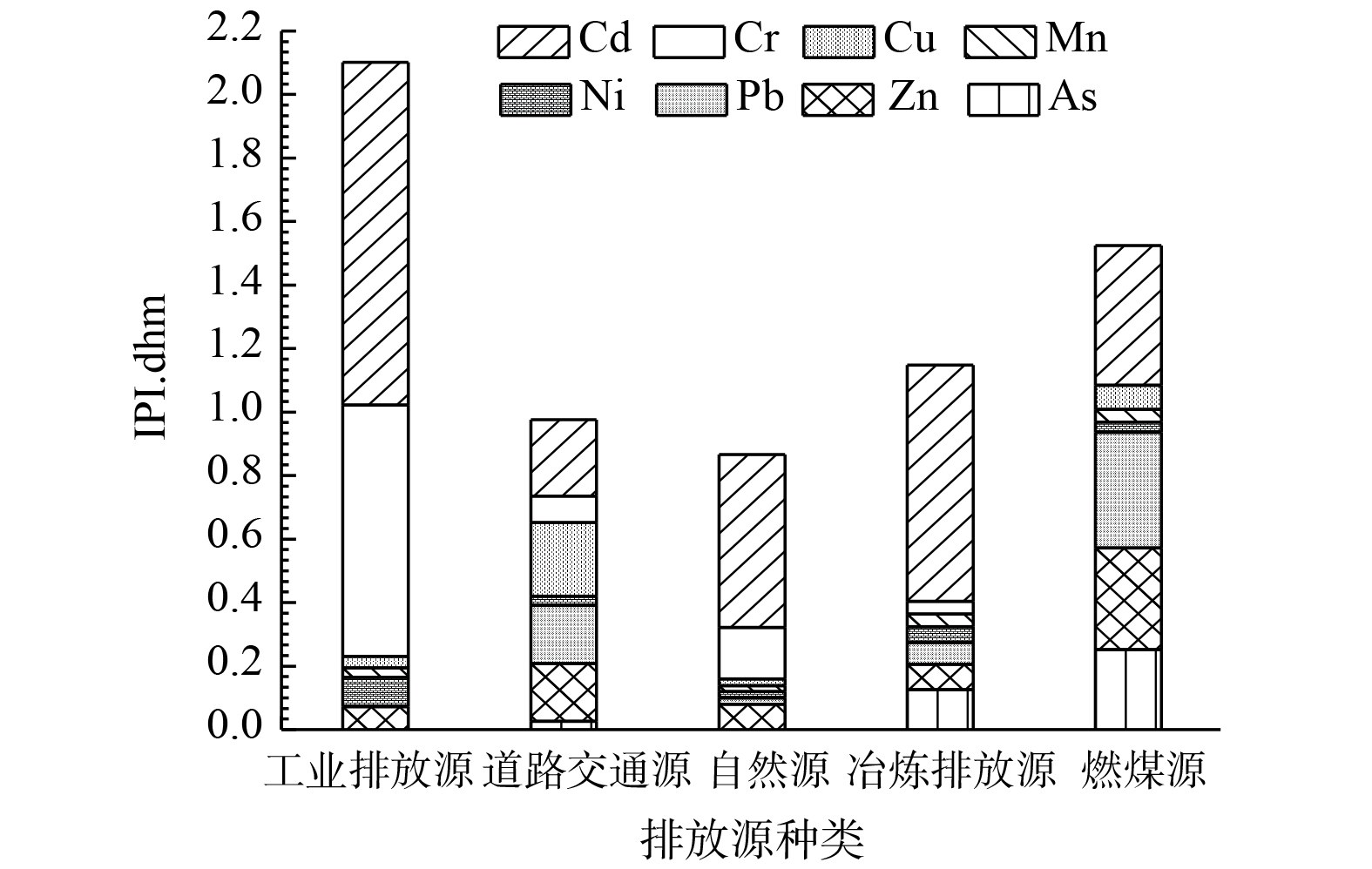-
大气降尘指空气动力学当量直径大于10 µm的颗粒物[1],其成分复杂,是多种污染物的载体,对衡量城市污染水平有重要的指示作用[2-3]。重金属作为降尘中污染组分之一,具有不可降解性、环境迁移性和生物累积性,不仅对生态环境构成潜在的危害,还会通过摄入、呼吸和皮肤接触等方式进入人体,进而危害人群健康[4-6]。李颖泉等[7]对兰州市主城区大气降尘和表层土壤重金属污染特征进行了评价,结果表明该地区大气降尘中的Cd 已构成严重污染。栾慧君等[8]对徐州北郊大气降尘重金属进行了污染特征分析与风险评价,结果表明Cu、Pb和Cd 存在中度以上污染,As 介于轻度和偏中度污染之间,且对儿童存在健康风险。
重金属污染评价方法主要有地累积指数法(Igeo) [9]、单因子污染指数法(SPI)[10]和潜在生态风险指数法(Er)等[11]。为对降尘中重金属的污染水平和生态风险进行综合评价,熊秋林等[12]基于上述3种方法提出了降尘重金属综合污染指数 (integrated pollution index of the dust heavy metal,IPI.dhm) 模型。
受体模型法是重金属源解析的常用方法,包括化学质量平衡法(chemical mass balance,CMB)[13]、绝对主成分分析-多元线性回归(absolute principal component score-multiple linear regression,APCS-MLR)[14]、正定矩阵因子分析法(positive matrix factorization,PMF)[15-16]和Unmix模型等[17-18]。以上方法通过从数据集中提取有意义的信息对样品进行分类,进而识别污染源。PMF模型是美国环保署推荐的源解析模型[15],在大气降尘重金属的源解析研究中得到了广泛应用[19-21]。APCS-MLR 基于PCA 演变而来,通过对原始数据进行标准化来计算因子的绝对真实得分( APCS) ,再结合多元线性回归模型计算因子对重金属的贡献率。APCS-MLR和PMF不需要预先测量的源配置文件,仅需要重金属浓度数据,比传统CMB 等受体模型更方便、高效。受限于模型算法,单一受体模型可能存在一定局限性。
近年来,邯郸市大气环境的研究主要集中于PM2.5/10的时空分布特征、源解析及风险评估等方面[22-25],而关于大气降尘中金属污染的研究较少。基于此,本研究选择PMF和APCS-MLR进行联合解析,相互比较验证,以提高源解析的准确性。邯郸市位于京津冀大气污染重点防治区域,市区内有钢铁冶炼厂和焦化厂等重污染企业,空气质量排名常年靠后。邯郸市机动车保有量持续增加,城市建设规模不断扩大,内源扬尘问题突出。因此,本研究以邯郸市主城区为研究对象,根据不同功能区布设3个采样点,采集2年的大气沉降样品,以分析10种金属元素的质量分数,并采用PMF和APCS-MLR两种受体模型对邯郸市大气降尘中金属来源进行解析,进而比较不同模型源解析的适用性,最终选择最适合本研究的受体模型,结合改进的降尘重金属综合污染指数模型综合定量评价不同污染源对大气降尘中8种重金属的污染程度,以期为控制地区重金属污染和大气颗粒污染物防治提供参考。
-
邯郸市位于河北省南部,西部是太行山脉,东部与华北平原相连接,与山西省、山东省和河南省三省接壤。其主城区总面积达434 km2,常住人口367.42×104 人。以温带大陆性气候为主,年均气温13.5 ℃,年降水量400~800 mm。夏季盛行东南风,冬季盛行西北风。
-
为较为全面地评价邯郸市主城区大气降尘重金属污染水平,在邯郸市主城区的不同功能区布设了3个大气沉降采样点(见图1),即矿院(KY)、河北邯郸市东污水处理厂(DW)和河钢集团邯钢公司(HG)。KY采样点位于河北工程大学能环学院实验楼顶(36.57ºN、114.50ºE),周边还有邯郸学院和邯郸职业技术学院等高校,代表高教区;DW采样点(36.63ºN、114.53ºE)位于联通大厦顶层,周围是居民小区、饭店和商场,代表生活区;HG采样点(36.60ºN、114.44ºE)位于邯郸钢铁公司污水处理站楼顶,该采样点为重工业企业所在地,代表工业区. 所有的采样点均设立在开阔的楼顶,高度约12~15 m,并避开烟囱和主要交通干道等局部污染源。周边环境可代表邯郸市主城区典型功能区环境。采用大气干湿沉降自动采样器(TE-78-100型,美国Tisch公司)收集大气干湿沉降,每月月底采集一次干沉降,降水后收集湿沉降,湿沉降经0.45 μm微孔滤膜过滤后于(105±5) ℃烘至恒质量。残留物与当月干沉降合并测量。于2017年12月—2019年11月共采集了72个大气降尘样品,采样周期为(30±2) d。降尘样品采集后密封带回实验室,去除落叶、昆虫等杂物后风干保存。
-
称取约0.05 g降尘样品放入PTFE消解罐,加入3 mL HCl、3 mL HNO3和1 mL HF,在180 ℃下密封消解2.5 h。然后把消解罐放在电热板上加热赶酸(150 ℃),待样品蒸至1 mL时,冷却至室温,用3%稀HNO3淋洗,并通过0.45 μm微孔滤膜过滤至100 mL容量瓶中定容。为减小误差,每12个样品同步进行1个全试剂空白对照,实验结果均扣除空白值。Al、Fe、Cu、Mn、Cd、Cr、Ni、Pb和Zn等9种金属元素含量采用ICP-MS(X Series 2型,美国Thermo Fisher公司)测定。由于ICP-MS检测As存在质谱干扰,故As采用原子荧光光度计(AFS-230E,中国让奇仪器科技有限公司)测定[26]。每批次抽取10%的样品进行平行样测定,相对标准偏差控制在≤5%;用土壤标准物质GBW07408(黄土土壤GSS-8)进行质量控制,各元素在标准物质中的回收率为84%~118%。
-
1) PMF模型。PMF模型是基于加权最小二乘法进行限定和迭代计算,不断地分解矩阵X以得到矩阵G和F,并将新矩阵进行优化求解,当目标函数Q 最小时即为最优解[15],计算公式见式 (1)~(3) 。
式中:Xij为第i个样品中第j种元素的含量,mg·kg−1;Gik为第k个因子对第i个样品的贡献率;Fkj为第k个因子中第j种元素的含量,mg·kg−1;Eij为第i个样品中第j种元素的残差;Q为PMF模型定义的目标函数;U为第i个样品中第j种元素的不确定度;MDL为检出限,mg·kg−1;δ为相对标准偏差;c为元素含量,mg·kg−1.
2) 绝对因子分析-多元线性回归 (APCS-MLR) 。绝对因子分析-多元线性回归 (APCS-MLR) 受体模型由 Thurston 和 Spengler(1985) 提出[14]。该方法的基本原理是利用主成分分析 (PCA) 得到的标准化因子得分和特征向量进行APCS-MLR定量源解析。首先,原始数据标准化公式如式 (4) 所示。
式中:Cij为第 i 个样本中第 j 种污染物的质量分数,mg·kg−1;
$ \stackrel{-}{{C}_{j}} $ 和为元素j的算术平均值;$ {\sigma }_{j} $ 为元素j的标准差。引入0浓度人为样本并标准化,计算公式为式 (5) 。
通过PCA 主成分分析可得到标准化后的污染物浓度样本的因子得分。每种污染物元素的绝对因子 (APCS) 可由真实样本的因子得分减去Z0的因子得分来估计。再将APCS 作为自变量,以重金属实测浓度为因变量进行多元线性回归分析,得到的回归系数可将APCS 转化为每个污染源对每个样本的浓度贡献,计算式如式 (6) 所示。
式中:Cj为重金属j质量分数浓度;b0j为重金属j多元回归常数项;bkj为源k对重金属j 的回归系数;APCSk为绝对主成分因子得分;p为因子个数;bkj·APCSk为源p对Cj的贡献率,所有样本的bkj·APCSk平均值代表了源的平均贡献。
在APCS-MLR模型中,贡献率计算过程中可能出现负值,影响源分配的准确性。为解决该问题,将所有负值取绝对值转换为正贡献,表示对应源对重金属的贡献率[16]。
-
熊秋林等[12]提出的IPI.dhm模型中的PI1是元素含量与背景值比值(BR)的归一化系数,对于元素的富集程度判断较为粗略,因此,将BR换为元素的富集因子(EF),并对其进行归一化计算,评价了8种重金属的综合污染指数(Cd、Cr、Cu、Mn、Ni、Pb、Zn和As),计算公式为式 (7) .
式中:IPI.dhm为降尘重金属综合污染指数,当IPI.dhm>0.5时,表示该元素为显著污染因子;PI1为重金属EF的归一化系数,当PI1>0.15时表示存在富集;PI2为重金属SPI的归一化系数, 当PI2>0.15时表示对土壤环境影响较大;PI3为重金属Igeo的归一化系数, 当PI3>0.15时为显著污染因子;PI4为重金属Er的归一化系数,当PI4>0.15时表示为显著生态风险危害因子。
式中:IPI.dhmk为第k种源的降尘重金属综合污染指数;j为元素种类,IPI.dhmi为元素i的降尘重金属综合污染指数;Sik为第i种元素在源k上的占比。
-
根据化学分析测试结果,分别统计了邯郸市3个功能区2017年12月—2019年11月大气降尘中10种金属元素含量的平均值,并选用河北省主要土类(A层)土壤背景值(简称“河北省土壤背景值”)做参比(见表1)。除Al之外,其他9种金属元素质量分数均超过了河北省土壤背景值。Mn和Zn的含量较高,分别为1 259.09和1 104.95 mg·kg−1;Cd质量分数最低,平均值小于10 mg·kg−1;Cd、Cr、Cu、Mn、Ni、Pb、Zn和As含量平均值分别为河北省土壤背景值的112.06、2.10、5.11、2.13、2.51、10.93、15.37和3.09倍。这表明邯郸市大气降尘重金属受人为扰动较大。Al的质量分数低于河北省土壤背景值;Fe的平均质量分数是河北省土壤背景值的2.69倍。
不同功能区元素含量也存在较大差异,总体来看工业区金属含量最高,生活区次之,高教区最小。这表明本地的工业活动对邯郸市降尘中金属含量存在显著影响。邯郸市以重工业为主,钢铁产业是邯郸工业第一大产业,2018年邯郸市粗钢产量为4.12×107 t,占河北省产量的17.40%,占全国总产量的4.50%,总体规模相当于世界第八大产钢国[27]。位于邯郸市主城区西南部的机械厂、冶炼厂等工业企业排放及繁忙的交通运输可能是造成该地区降尘中重金属元素含量较高的原因。
表2表明,与国内外其他城市相比,邯郸市大气降尘中Cd和Zn的质量分数低于焦作市,但远高于北京市、徐州市、安庆市、鞍山市、泉州市、重庆市、莫斯科市、伊斯法罕市和渥太华市,为含量最低的莫斯科市22.46和19.73倍。Cr的质量分数低于鞍山市,略高于其他城市。As的质量分数低于安庆和伊斯法罕,与徐州和焦作相当。Ni与Pb的质量分数仅低于泉州市。Cu的质量分数与鞍山和加尔各答相当,但远高于焦作、莫斯科。工业和交通运输对大气降尘中重金属含量有较大影响,工业区降尘重金属含量高于其他地区。这点在本研究区域表现尤为明显[8,28-30]。
-
采用EPA PMF 5.0进行源解析,大气降尘中金属属于未知源成分谱,需设置因子数,使Q值最小,以得到最优解析结果。根据金属元素的可能来源,选择因子数为3~6 进行迭代运算20次,通过比较不同因子数时QRobust/Qtrue大小来确定最佳因子数。其中,QRobust为PMF 模型在Robust 模式下得到的目标函数Q 的最优解,而Qtrue为目标函数Q 的真值。当因子数为5时,QRobust与Qtrue差别最小,97%残差值在-3~3。QRobust 与Qtrue为PMF中衡量模型拟合度的参数,此时R2 为 0.57~1 ,除As的R2为0.57,其余元素的R2均大于0.70。这说明该方法的整体解析效果较好,解析结果如图2所示。
PMF的因子1中含量载荷较高的元素为Pb、Zn和As,贡献率分别为56.60%、39.43%和60.74%(PMF)。由于我国2000年全面禁止销售和使用含铅汽油,并且规定了汽油中的Pb限值(0.005 g·L−1,GB17930—2011车用汽油国家标准),因此,普遍认为高含量负载的Pb来自于燃煤而非汽车尾气排放[9,37]。As是燃煤排放的标志性元素[1,38-39]。GE等[40]发现,Zn和Pb是民用燃煤排放中主要的重金属元素。重工业和火电厂生产及农村地区散煤燃烧均需要消耗大量煤炭,2018年和2019年邯郸市燃煤消耗量分别为4.01×107和4.10×107 t,增长2.01%[41]。因此,判断因子1与燃煤活动有关。
PMF的因子2中Fe和Mn的含量载荷较高,贡献率分别为59.42%和38.30%。值得一提的是,Fe在因子2中的占比远高于其他因子。Mn属于铁族元素,其原子半径和化学形态与Fe相似,易在铁矿中共生富集[42]。河北省是中国钢铁产量第一大省,而邯郸市是河北省重要的钢铁产地[41,43]。同时,Mn在已测得的8种重金属元素中含量最高,故判断Mn主要来自于该地区钢铁冶炼。邯郸市工业区有大型钢铁企业,大量的冶炼烟气进入大气环境中,这说明因子2与冶炼排放有关。
PMF的因子3中Al的含量载荷最高,贡献率为86.66%,Fe和Mn的含量载荷分别为26.68%和14.53%。Al在地壳中分布相对均匀且含量比较稳定,通常作为自然源的示踪元素。相关研究表明土壤颗粒物也是Fe和Mn的重要来源,因此PMF的因子3中Fe和Mn载荷可能受到土壤尘的影响[28,36,44]。ZHANG等[45]发现邯郸市大气颗粒物含量也受到来自蒙古及其北部地区沙尘的影响。邯郸市在近些年开展城市东部新区建设,城市中有大量大面积建筑工地和裸露地表。这也是该城市土壤尘的重要来源,故因子3归为自然源。
因子4对Cu和Zn的相对贡献较高,贡献率分别为61.90%和27.05%(见图2)。交通工具的制动器和散热片制造过程中普遍添加Cu,汽车尾气中含有Cu,尤其是柴油车,这导致Cu在环境中持续累积[19,29,46]。Zn作为添加剂广泛应用于汽车轮胎等橡胶制品,车辆的日常损耗会导致Zn累积[1,19,47]。邯郸市汽车保有量巨大,2019年全市机动车保有量达185.58×104辆,较2018年增长了7.4%[41,43]。因此,判断因子4为道路交通源。
因子5中Cr、Ni和Cd占比较高,贡献率分别为69.61%、37.91%和49.56%。这2个源的结果具有一定相似性。Cr和Ni主要来自于成土过程和工业生产,描述性统计显示研究区域大气降尘中Cr和Ni均超过河北省土壤背景值,说明这2种元素受人为影响较大。一般研究认为Cr和Ni与采矿、冶炼、金属加工等活动有关[1,28-29]。Cd来自金属加工及交通运输,邯郸市区内有多个锌镍合金加工厂,因此,判断因子5为工业排放源。
将研究区域大气降尘重金属含量进行标准化处理,采用KMO-Bartlett 球形检验。KMO 检验系数0.566>0.5,Bartlett’s球形检验P <0.001。这表明各重金属元素之间可能存在统计学上显著的相关性,适合进行因子分析。为减少各因子原始变量的重叠,采用varimax 旋转法。按照初始特征值大于1的原则提取了3个主成分,分别可解释总方差的32.31%、26.87%和19.38%,累计方差为78.56%。这表明这3个因子可反映数据的大部分信息,相关结果见图3。
F1中Fe、Cd、Cr、Mn、Ni和Zn占比较高,贡献率分别为44.66%、52.74%、90.56%、74.61%、73.75%和81.22%。这些金属是典型的工业排放元素,因此,将F1归为工业与冶炼排放源。
F2载荷较高的元素为Cu、Pb和As,贡献率分别为80.34%、88.47%和61.64%,与PMF的因子1具有一定的相似性。Pb和As是燃煤的典型示踪元素,而Cu与交通运输及燃煤有关,因此,判断F2为燃煤与交通混合源。
F3中Al有较高的载荷,贡献率为99.52%。Al在采集的降尘样品中的含量低于河北省土壤背景值,且其化学性质稳定,因此,判断F3为自然源。
-
在PCA 识别可能污染源的基础上,利用APCS-MLR模型建立了各污染源与元素浓度的函数关系,根据多元线性回归方程的回归系数分别计算各金属来源的贡献率。PMF和APCS-MLR的贡献率见图4。PMF识别出了5个源,自然源和冶炼排放源占比最大,贡献率分别为40.22%和41.29%;其他3个源为燃煤排放源、道路交通源和工业排放源,贡献率分别为2.18%、6.13%、10.17 (图4 (a) )。APCS-MLR模型识别出了3个源,工业与冶炼排放源占比最大,贡献率为50.74%;其次是自然源,贡献率为30.32%;燃烧与交通混合源贡献最少,贡献率为18.93% (图4 (b) )。这2种受体模型均识别出工业源、交通源和自然源是研究区域大气降尘重金属的主要来源。
-
模型获得的重金属含量模拟值与实测值之间的拟合程度能直观反映模型匹配度,估计值/实测值 (E/M) 和r2越接近1,则拟合效果越好。2种模型的比较结果见表3。
PMF模型中10种元素的r2平均值为 (0.89±0.12) ,而APCS-MLR模型的r2平均值为 (0.86±0.08),因此,PMF比APCS-MLR拟合度更高。PMF的E/M平均值为 (0.97±0.05) ,大于APCS-MLR (0.91±0.08),从匹配程度来说PMF较APCS-MLR更优。
从源解析结果来看,这3种受体模型均识别出工业源、交通源和自然源是研究区域大气降尘重金属的主要来源 (图5) 。2种受体模型由于算法差异,其解析出的源成分谱并不完全相同。相较于APCS-MLR解析出的混合源,PMF细分出了更多的源,如以Fe和Mn为主要浓度载荷的冶炼排放源。同时,该模型对Fe (r2=1) 和Mn (r2=0.99) 的拟合度较好,且Fe在工业区含量高于生活区和高教区,因此认为冶炼排放是Fe在大气降尘中污染的主要原因。同时虽然两种受体模型对As的r2值接近,但PMF细分出以As为主要载荷贡献的燃煤排放源,这也进一步反映出PMF的解析结果更优。
总体来看,PMF对元素的拟合和源解析结果大多与APCS-MLR相似,但PMF基于信噪比识别质量较差的元素,并对每个元素浓度及其不确定参数进行逐点加权估计,解析结果可解释大多数物种的来源。这也是PMF在源解析方面表现较好的主要原因[17-18]。然而, APCS-MLR仅利用浓度数据进行加权,降低误差的方法相对粗略,另外APCS-MLR不要求删除元素负荷中的负值,故会影响源识别的结果。
-
采用IPI.dhm模型对邯郸市大气降尘中重金属进行污染评价,分别计算了高教区、生活区和工业区降尘样品中8种重金属元素的PI1、PI2、PI3和PI4,在此基础上得到3个功能区重金属综合污染指数并计算出其平均值(表4)。
邯郸市3个功能区Cd的PI1、PI3和PI4均为1.00,远高于其他元素。这表明Cd富集程度、污染水平和生态风险极高,受人类社会工业及经济活动影响严重;Cr的PI2值为1.00,故Cr是邯郸市降尘中污染贡献程度较高的金属。3个功能区Cu、Ni、Pb、Zn和As的PI3均大于0.15,这表明这5种元素存在一定程度的污染。IPI.dhm的平均值依次为Cd>Cr>Zn>Pb>Cu>As>Ni>Mn,前4种金属元素的IPI.dhm平均值>0.5,为显著污染因子。这4种元素与工业及燃煤活动密切相关。Cd的IPI.dhm平均值远高于其他元素,说明该元素带来的污染极为严重。这一结果与国内多个地区的研究一致。张夏等[32]对重庆市主城区空气降尘中重金属污染特征进行了研究,发现6类功能区的Cd均为重度污染。 FENG等[48]研究了长沙市大气降尘对水稻土中重金属累积量的影响,发现Cd的土壤累积量最大。CAI等[49]对石家庄市大气降尘重金属进行了研究,发现该地区大气降尘中Cd含量是河北省土壤背景值的18倍,处于严重污染水平。大气降尘是表层土壤重金属的重要来源[48],因此,对大气降尘中重金属进行深入研究十分必要,尤其是Cd等重污染元素,应予以重要关注。
-
结合PMF模型解析结果和IPI.dhm值定量计算各源的污染贡献,结果如图5所示。各源对重金属综合污染的贡献依次为工业排放源(32.81%)>燃煤排放源(21.73%)>冶炼排放源(16.80%)>道路交通源(15.02%)>自然源(13.63%)。工业排放源是邯郸市大气降尘重金属综合污染的最大贡献,燃煤源次之,这2种源与城市能源结构密切相关。邯郸市大气降尘重金属存在显著污染,与兰州市[7,44]、焦作市[28]、鞍山市[30]等工业城市的结果一致。控制工业排放和推进清洁能源使用有利于降低邯郸市大气降尘重金属的污染程度。邯郸市政府已采取多项减排措施,如依法关停部分污染企业、搬迁部分重污染产业和“煤改气”等,但是大气降尘重金属污染依然较为严重。因此,政府部门应根据当地情况,强化环境管理措施,加大对企业的监管力度,推广清洁能源,进而有效控制区域降尘重金属污染。
-
1) 邯郸市大气降尘中除Al外,其他9种元素质量分数均高于河北省土壤背景值。其中Cd的超标倍数最大,质量分数是土壤背景值的112.06倍。不同功能区的金属元素含量存在明显差异,工业区金属含量总体最高,受人类经济活动影响较大。
2) PMF模型解析出5个源,分别是燃煤排放源(2.18%)、冶炼排放源(40.22%)、自然源(41.29%)、道路交通源(6.13%)和工业排放源(10.17%)。APCS-MLR解析出3个源,分别是的工业与冶炼排放源(50.74%)、燃煤和交通混合源(18.93%)、自然源(30.32%)。总体上看,研究区域土壤重金属主要受地区工业排放和繁忙的交通运输等人为活动的影响,自然源影响较小。
3) 相较于APCS-MLR模型,PMF解析出的源种类更详细,且PMF的r2及估计值/实测值(E/M)优于APCS-MLR模型,因此,PMF更适用于本地区大气降尘重金属的源解析。
4) 邯郸市3个功能区Cd、Cr、Pb和Zn的IPI.dhm值均大于0.5,是大气降尘的显著污染因子。工业排放源、燃煤源、冶炼排放源、道路交通源和自然源的污染贡献率分别为 32.81%、21.73%、16.80%、15.02%和13.63%。工业排放源和燃煤源是邯郸市大气降尘重金属污染的主要来源,故控制工业排放和推进清洁能源是控制区域大气降尘重金属的有效途径。
基于PMF和APCS-MLR模型的工业城市大气降尘金属源解析及综合污染评价
Source apportionment of metals in atmospheric deposition of a typical industrial city based on PMF and APCS-MLR and comprehensive pollution assessment
-
摘要: 为研究邯郸市区大气降尘的污染状况,在3个功能区逐月采集了2年的大气降尘样品,分析了降尘中Al、Fe、Cd、Cr、Cu、Mn、Ni、Pb、Zn和As等10种金属元素的质量分数,使用正定矩阵因子分解模型(PMF)和绝对主成分-多元线性回归模型(APCS-MLR)解析其来源,并采用大气降尘重金属综合污染指数(IPI.dhm)模型评估8种重金属(Cd、Cr、Cu、Mn、Ni、Pb、Zn和As)的污染水平,并结合最优源解析结果定量计算各源的污染贡献。结果表明:除Al外,邯郸市大气降尘中9种金属元素质量分数均超过河北省(A层)土壤背景值,不同功能区元素含量差异明显;PMF模型解析出5个源,分别为燃煤源、冶炼排放源、自然源、道路交通源和工业排放源;APCS-MLR解析出3个源,分别是工业与冶炼排放源,燃煤和交通混合源及自然源;PMF的解析结果更优。IPI.dhm结果显示,Cd、Cr、Zn和Pb为显著污染因子。基于源贡献的污染评估结果表明,5个源的贡献率依次为工业排放源(32.81%)>燃煤源(21.73%)>冶炼排放源(16.80%)>道路交通源(15.02%)>自然源(13.63%)。以上结果表明,该地区大气降尘重金属污染主要受工业和燃煤排放影响,建议优先控制工业排放和推进清洁能源以控制区域降尘重金属污染。本研究用到的大气降尘污染的来源解析与综合污染评价方法可为其他工业城市的提供参考。Abstract: In order to study the pollution situation of atmospheric deposition in Handan urban area, 3 sampling sites were set and 72 atmospheric deposition samples had been collected monthly from December 2017 to November 2019 by atmospheric dry and wet deposition autosampler. Contents of 10 metals (Al, Fe, Cd, Cr, Cu, Mn, Ni, Pb, Zn and As) in the atmospheric deposition samples were measured. The sources of metals were identified by positive matrix factorization model (PMF) and absolute principal component score-multiple linear regression receptor modeling (APCS-MLR). The results of two receptor models were compared. The pollution level of 8 heavy metals was assessed by the integrated pollution index of the dust heavy metal (IPI.dhm) model. The pollution contributions of each source were quantitatively calculated in combination with the source apportionment results of more suitable model. Results showed that except for Al, all 9 metals in the atmospheric deposition exceeded the corresponding soil background values for Hebei Province (A layer). 5 sources of metals in the atmospheric deposition were identified by PMF model: source, smelting emission source, natural source, transportation source and industrial emission source. 3 factors were identified by APCS-MLR: industrial smelter emission source, natural source, coal-burning and transportation mixed source. Better results of PMF were observed in this study. PMF were better than APCS-MLR. The result of IPI.dhm model showed that Cd, Cr, Zn and Pb were the significant pollution factors. Based on the pollution assessment result of source apportionment, the pollution contribution rates of the 5 sources were in order of industrial emission source (32.81%) > coal-burning source (21.73%) > smelting emission source (16.80%) > transportation source (15.02%) > natural source (13.63%). The study showed that the heavy metal pollution of atmospheric deposition in Handan urban area was mainly affected by industrial and coal-burning emissions. It is suggested that industrial emissions should be controlled priority and clean energy should be promoted, which could control the heavy metal pollution of atmospheric deposition in the area.
-
Key words:
- heavy metal /
- source apportionment /
- PMF /
- APCS-MLR /
- comprehensive pollution assessment
-

-
表 1 大气降尘中金属元素的质量分数
Table 1. Concentrations of metals in atmospheric deposition
数据种类 Al/% Fe/% Cd/
(mg·kg−1)Cr/
(mg·kg−1)Cu/
(mg·kg−1)Mn/
(mg·kg−1)Ni/
(mg·kg−1)Pb/
(mg·kg−1)Zn/
(mg·kg−1)As/
(mg·kg−1)高教区 3.04±
2.394.32±
0.965.07±
1.33101.94±
100.5894.86±
51.721 029.10±
236.1362.41±
42.12198.88±
123.681 031.83±
214.7733.83±
7.69生活区 4.06±
2.744.95±
1.896.85±
4.28143.95±
133.11106.79±
39.081 171.26±
381.2980.77±
55.59223.92±
118.201 190.32±
547.0939.81±
13.14工业区 3.51±
2.7313.55±
3.988.28±
3.81166.83±
116.93120.43±
112.501 576.92±
649.9873.24±
49.39249.11±
120.771 092.69±
395.0544.85±
6.613个区域
平均值3.53±
2.627.61±
4.966.73±
3.60137.57±
119.06107.35±
74.651 259.09±
506.6172.14±
9.23223.97±
20.971 104.95±
408.3939.51±
10.48河北省土
壤背景值6.72±
1.002.82±
0.690.06±
3.5765.40±
1.3321.00±
1.34592.00±
1.3028.70±
1.4620.50±
1.3671.90±
1.4912.80±
1.44注:表中所示数据为平均值±标准偏差;背景值为河北省主要土类(A层土壤)背景值。 表 2 邯郸市及国内外部分城市大气降尘中重金属质量分数
Table 2. Content of heavy metals in atmospheric deposition in Handan and some cities of China and abroad
mg·kg−1 地点 Cd Cr Cu Mn Ni Pb Zn As 数据来源 中国邯郸 6.74 137.58 107.36 1 259.10 72.14 223.97 1 104.95 39.50 本研究 中国徐州 1.15 111.52 162.09 — — 201.29 — 32.00 文献[8] 中国北京 2.00 128.30 144.90 — 51.50 93.50 572.20 — 文献[12] 中国焦作 8.11 68.90 68.07 — 40.22 157.15 1 809.60 35.47 文献[28] 中国安庆 2.98 128.70 134.10 — 55.40 128.90 640.00 63.90 文献[29] 中国鞍山 0.96 183.70 101.70 939.00 42.50 2080 597.00 12.19 文献[30] 中国泉州 2.81 125.40 122.70 1 061.00 84.83 256.40 975.00 — 文献[31] 中国重庆 1.59 72.68 — — 20.99 101.17 — — 文献[32] 俄罗斯莫斯科 0.30 3.70 7.30 390.00 3.70 0.70 56.00 0.30 文献[33] 伊朗伊斯法罕 0.98 37.20 67.00 — 53.40 96.30 400.30 50.60 文献[34] 加拿大渥太华 0.37 43.30 65.84 — 15.20 39.10 112.50 1.30 文献[35] 印度加尔各答 — 164 92 743 36 128 289 — 文献[36] 注:—表示缺少数据。 表 3 PMF和APCS-MLR适用性的比较
Table 3. Comparison of fitting degree of PMF and APCS-MLR
元素种类 实测值/(mg·kg−1) PMF APCS-MLR 估计值/(mg·kg−1) r2 E/M 估计值/(mg·kg−1) r2 E/M Al 35 378.31 35 378.31 1 1 32 548.05 0.87 0.92 Fe 76 086.62 76 086.62 1 1 67 717.09 0.92 0.89 Cd 6.74 6.23 0.75 0.92 6.87 0.90 1.02 Cr 137.58 137.18 0.99 0.98 132.08 0.91 0.96 Cu 107.36 88.52 0.88 0.82 85.89 0.77 0.80 Mn 1 259.10 1 259.06 0.99 1.00 1 158.37 0.92 0.92 Ni 72.14 73.36 0.82 1.02 69.25 0.89 0.96 Pb 223.97 221.63 0.94 0.99 230.69 0.94 1.03 Zn 1 104.95 1 082.02 0.85 0.98 950.26 0.79 0.86 As 39.50 38.01 0.63 0.96 30.42 0.69 0.77 表 4 不同功能区重金属综合污染指数
Table 4. Mean IPI.dhm of heavy metals in different functional area
IPI.dhm 高教区 生活区 工业区 平均值 Cd 3.01 3.01 3.01 3.01 Cr 1 1 1 1 Cu 0.36 0.36 0.3 0.34 Mn 0.13 0.11 0.15 0.13 Ni 0.18 0.17 0.11 0.15 Pb 0.63 0.6 0.58 0.6 Zn 0.75 0.71 0.63 0.7 As 0.37 0.3 0.28 0.32 -
[1] 刘杰, 高敏, 梁俊宁, 等. 陕西省某工业园区春季大气降尘重金属污染特征及评价[J]. 环境科学研究, 2019, 32(7): 1195-1203. [2] MANTA D S, ANGELONE M, BELLANCA A, et al. Heavy metals in urban soils: A case study from the city of Palermo (Sicily), Italy[J]. Science of the Total Environment, 2002, 300(1/2/3): 229-243. doi: 10.1016/S0048-9697(02)00273-5 [3] VALLACK H W, SHILLITO D E. Suggested guidelines for deposited ambient dust[J]. Atmospheric Environment, 1998, 32(16): 2737-2744. doi: 10.1016/S1352-2310(98)00037-5 [4] ZHANG Y Y, JI X T, KU T T, et al. Heavy metals bound to fine particulate matter from Northern China induce season-dependent health risks: a study based on myocardial toxicity[J]. Environmental Pollution, 2016, 216: 380-390. doi: 10.1016/j.envpol.2016.05.072 [5] 周珂, 郭姝荃, 周新萌, 等. 武汉市降尘污染特征及影响因素[J]. 中国环境监测, 2016, 32(1): 58-63. doi: 10.3969/j.issn.1002-6002.2016.01.011 [6] DAI J R. Geochemical characteristics and pollution source identification of the near-surface atmosphere dust-fall in Jining City, Eastern China[J]. Agricultural Biotechnology, 2019, 8(1): 199-205. https://kns.cnki.net/KCMS/detail/detail. aspx?filename=AGBT201901048&dbname=CJFD&dbcode=CJFQhttps://oversea.cnki.net/KCMS/detail/detail.aspx?filename=AGBT201901048&dbname=CJFD&dbcode=CJFQ [7] 李颖泉, 赵保卫, 牛武江, 等. 兰州市主城区大气降尘和表层土壤重金属污染特征与评价[J]. 安全与环境学报, 2020, 20(4): 1440-1448. [8] 栾慧君, 塞古, 徐蕾, 等. 徐州北郊大气降尘重金属污染特征与风险评价[J]. 中国环境科学, 2020, 40(11): 4679-4687. doi: 10.3969/j.issn.1000-6923.2020.11.005 [9] MÜLLER G. Index of geoaccumulation in sediments of the Rhine River[J]. Geology Journal, 1969, 2: 108-118. [10] 肖作义, 赵鑫, 孟庆学, 等. 内蒙古某尾矿库土壤重金属污染健康风险评价与来源解析[J]. 有色金属工程, 2020, 10(12): 135-142. doi: 10.3969/j.issn.2095-1744.2020.12.019 [11] HAKANSON L. An ecological risk index for aquatic pollution control. a sedimentological approach[J]. Water Research, 1980, 14(8): 975-1001. doi: 10.1016/0043-1354(80)90143-8 [12] 熊秋林, 赵文吉, 李大军, 等. 北京冬季降尘重金属富集程度及综合污染评价[J]. 环境科学, 2018, 39(9): 4051-4059. [13] 黄国兰, 萧航, 陈春江, 等. 化学质量平衡法在水体污染物源解析中的应用[J]. 环境科学, 1999, 20(6): 14-17. doi: 10.13227/j.hjkx.1999.06.004 [14] THURSTON G D, SPENGLER J D. A quantitative assessment of source contributions to inhalable particulate matter pollution in metropolitan Boston[J]. Atmospheric Environment, 1985, 19(1): 9-25. doi: 10.1016/0004-6981(85)90132-5 [15] PAATERO P, TAPPER U. Positive matrix factorization: A non-negative factor model with optimal utilization of error estimates of data values[J]. Environmetrics, 1994, 5(2): 111-126. doi: 10.1002/env.3170050203 [16] GHOLIZADEH M H, MELESSE A M, REDDI L. Water quality assessment and apportionment of contamination sources using APCS-MLR and PMF receptor modeling techniques in three major rivers of South Florida[J]. Science of the Total Environment, 2016, 566-567(10): 1552-1567. [17] ZHANG H X, CAI A Z, WANG X J, et al. Risk assessment and source apportionment of heavy metals in soils from Handan City[J]. Applied Sciences. 2021, 11(20): 9615. [18] 蔡昂祖, 张海霞, 王小剑, 等. Unmix模型污染源解析研究进展及应用前景[J]. 土壤通报, 2021, 52(3): 747-756. doi: 10.19336/j.cnki.trtb.2020081401 [19] 孙昂, 曹景丽, 王明仕, 等. 典型工业城市中小学降尘重金属风险评估和源解析研究[J]. 地球与环境, 2021, 49(6): 655-664. SUN A, CAO J L, WANG M S, et al. Risk assessment and source apportionment of heavy metals in dust fall in primary and secondary schools of a typical industrial city[J]. Earth and Environment, 2021, 49(6): 655-664.
[20] 杨新明, 钟雅琪, 李国锋, 等. 典型工业城市大气降尘中重金属分布特征及其来源解析--以济南市为例[J]. 环境化学, 2022, 41(2): 1-10. [21] YE L M, HUANG M J, ZHONG B Q, et al. Wet and dry deposition fluxes of heavy metals in Pearl River Delta Region (China): Characteristics, ecological risk assessment, and source apportionment[J]. Journal of Environmental Sciences, 2018, 70(8): 106-123. [22] YANG S, MA Y L, DUAN F K, et al. Characteristics and formation of typical winter haze in Handan, one of the most polluted cities in China[J]. Science of the Total Environment, 2018, 613/614: 1367-1375. doi: 10.1016/j.scitotenv.2017.08.033 [23] CAI A Z, ZHANG H X, WANG L T, et al. Source apportionment and health risk assessment of heavy metals in PM2.5 in Handan: a typical heavily polluted city in North China[J]. Atmosphere, 2021, 12(10): 1232. doi: 10.3390/atmos12101232 [24] WANG L T, WEI Z, YANG J, et al. The 2013 severe haze over southern Hebei, China: model evaluation, source apportionment, and policy implications[J]. Atmospheric Chemistry and Physics, 2014, 14(6): 3151-3173. doi: 10.5194/acp-14-3151-2014 [25] WANG L T, FU J S, WEI W, et al. How aerosol direct effects influence the source contributions to PM_2.5 concentrations over Southern Hebei, China in severe winter haze episodes[J]. Frontiers of Environmental Science & Engineering, 2018, 12(3): 1-13. doi: 10.1007/s11783-018-1014-2 [26] 林立, 王琳琳. 采用ICP-MS/MS对硒和砷检测的质谱干扰[J]. 分析试验室, 2016, 35(3): 344-348. doi: 10.13595/j.cnki.issn1000-0720.2016.0081 [27] 邯郸市人民政府. 邯郸市人民政府关于印发邯郸市精品钢材产业发展规划(2019-2025年)的通知[EB/OL]. https://www.hd.gov.cn/hdzfxxgk/gszbm/auto23692/202003/t20200318_1254763.html [28] 王明仕, 曹景丽, 李晗, 等. 焦作市采暖期降尘中重金属生态风险评价与源解析[J]. 生态环境学报, 2017, 26(5): 824-830. [29] 方文稳, 张丽, 叶生霞, 等. 安庆市降尘重金属的污染评价与健康风险评价[J]. 中国环境科学, 2015, 35(12): 3795-3803. doi: 10.3969/j.issn.1000-6923.2015.12.034 [30] 邢小茹, 薛生国, 张乃英, 等. 鞍山市大气尘和金属元素沉降通量及污染特征[J]. 中国环境监测, 2010, 26(2): 11-15. doi: 10.3969/j.issn.1002-6002.2010.02.003 [31] 张棕巍, 胡恭任, 于瑞莲, 等. 泉州市大气降尘中金属元素污染特征及来源解析[J]. 环境科学, 2016, 37(8): 2881-2888. [32] 张夏, 刘斌, 肖柏林, 等. 重庆主城大气降尘中重金属污染特征及评价[J]. 环境科学, 2020, 41(12): 5288-5294. [33] VERGEL K, ZINICOVSCAIA I, YUSHIN N, et al. Heavy metal atmospheric deposition study in Moscow region, Russia[J]. Bulletin of Environmental Contamination and Toxicology, 2019, 103(3): 435-440. doi: 10.1007/s00128-019-02672-4 [34] NOROUZI S, KHADEMI H, AYOUBI S, et al. Seasonal and spatial variations in dust deposition rate and concentrations of dust-borne heavy metals, a case study from Isfahan, central Iran[J]. Atmospheric Pollution Research, 2017, 8(4): 686-699. doi: 10.1016/j.apr.2016.12.015 [35] RASMUSSEN P E, SUBRAMANIAN K S, JESSIMAN B J. A multi-element profile of house dust in relation to exterior dust and soils in the city of Ottawa, Canada[J]. Science of the Total Environment, 2001, 267(1/2/3): 125-140. doi: 10.1016/S0048-9697(00)00775-0 [36] KOLAKKANDI V, SHARMA B, RANA A, et al. Spatially resolved distribution, sources and health risks of heavy metals in size-fractionated road dust from 57 sites across megacity Kolkata, India[J]. Science of the Total Environment, 2020, 705: 135805. doi: 10.1016/j.scitotenv.2019.135805 [37] DUAN J C, GUO S J, TAN J H, et al. Characteristics of atmospheric carbonyls during haze days in Beijing, China[J]. Atmospheric Research, 2012, 114/115: 17-27. doi: 10.1016/j.atmosres.2012.05.010 [38] 张银晓, 卢春颖, 张剑, 等. 民用燃煤排放细颗粒中金属元素排放特征及单颗粒分析[J]. 中国环境科学, 2018, 38(9): 3273-3279. doi: 10.3969/j.issn.1000-6923.2018.09.009 [39] ZANNONI D, VALOTTO G, VISIN F, et al. Sources and distribution of tracer elements in road dust: the Venice mainland case of study[J]. Journal of Geochemical Exploration, 2016, 166: 64-72. doi: 10.1016/j.gexplo.2016.04.007 [40] GE S, XU X, CHOW J C, et al. Emissions of air pollutants from household stoves: honeycomb coal versus coal cake[J]. Environmental Science & Technology, 2004, 38(17): 4612-4618. doi: 10.1021/es049942k [41] 邯郸市统计局. 邯郸统计年鉴. 2018[M]. 北京: 中国统计出版社. [42] XU S, TAO S. Coregionalization analysis of heavy metals in the surface soil of Inner Mongolia[J]. Science of the Total Environment, 2004, 320(1): 73-87. doi: 10.1016/S0048-9697(03)00450-9 [43] 邯郸市统计局. 邯郸统计年鉴. 2019[M]. 北京: 中国统计出版社. [44] 黄文, 王胜利. 兰州市采暖期和非采暖期大气降尘重金属的分布特征及来源[J]. 环境科学, 2022, 43(2): 597-607. doi: 10.13227/j.hjkx.202103222 [45] ZHANG C Y, LITAO WANG L, QI M Y, et al. Evolution of key chemical components in PM2.5 and potential formation mechanisms of serious haze events in Handan, China[J]. Aerosol and Air Quality Research, 2018, 18(7): 1545-1557. doi: 10.4209/aaqr.2017.10.0386 [46] LV J S. Multivariate receptor models and robust geostatistics to estimate source apportionment of heavy metals in soils[J]. Environmental Pollution, 2019, 244: 72-83. doi: 10.1016/j.envpol.2018.09.147 [47] 刘玲玲, 安燕飞, 马瑾, 等. 基于UNMIX模型的北京城区公园土壤重金属源解析[J]. 环境科学研究, 2020, 33(12): 2856-2863. [48] FENG W L, GUO Z H, PENG C, et al. Atmospheric bulk deposition of heavy metal(loid)s in central South China: Fluxes, influencing factors and implication for paddy soils[J]. Journal of Hazardous Materials, 2019, 371: 634-642. doi: 10.1016/j.jhazmat.2019.02.090 [49] CAI K, LI C, NA S. Spatial distribution, pollution source, and health risk assessment of heavy metals in atmospheric depositions: a case study from the sustainable city of Shijiazhuang, China[J]. Atmosphere, 2019, 10(4): 222. doi: 10.3390/atmos10040222 -




 下载:
下载:







